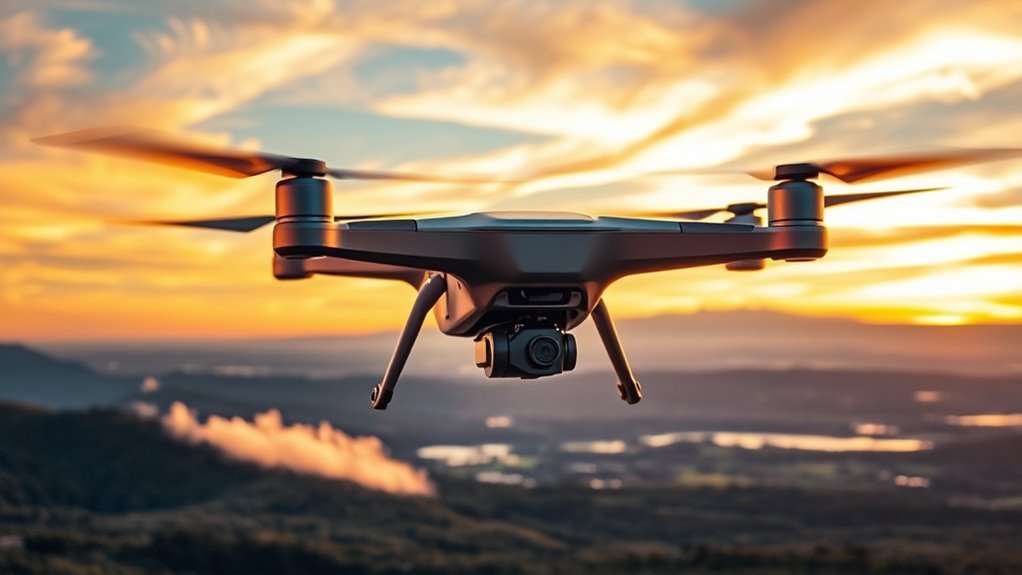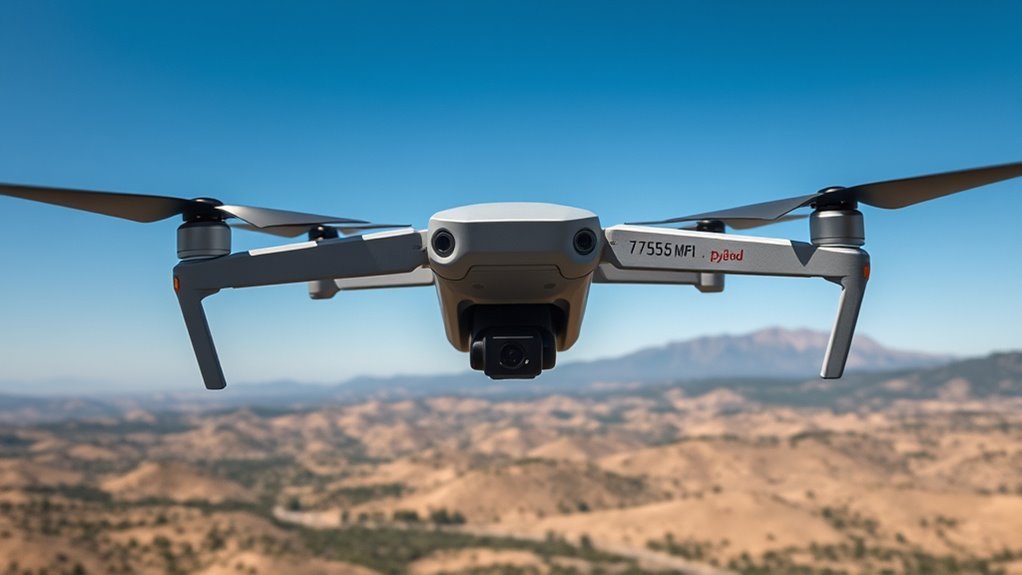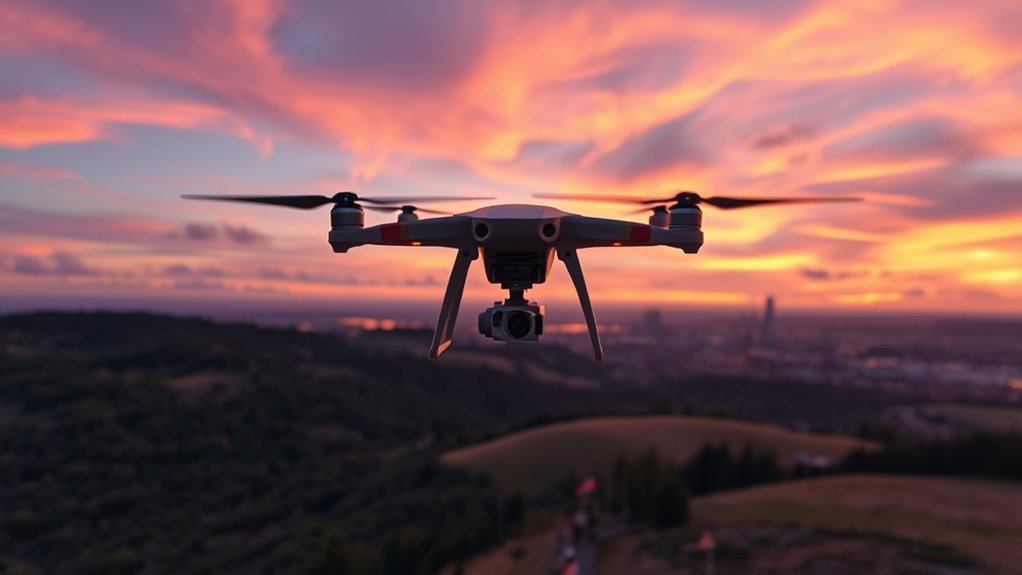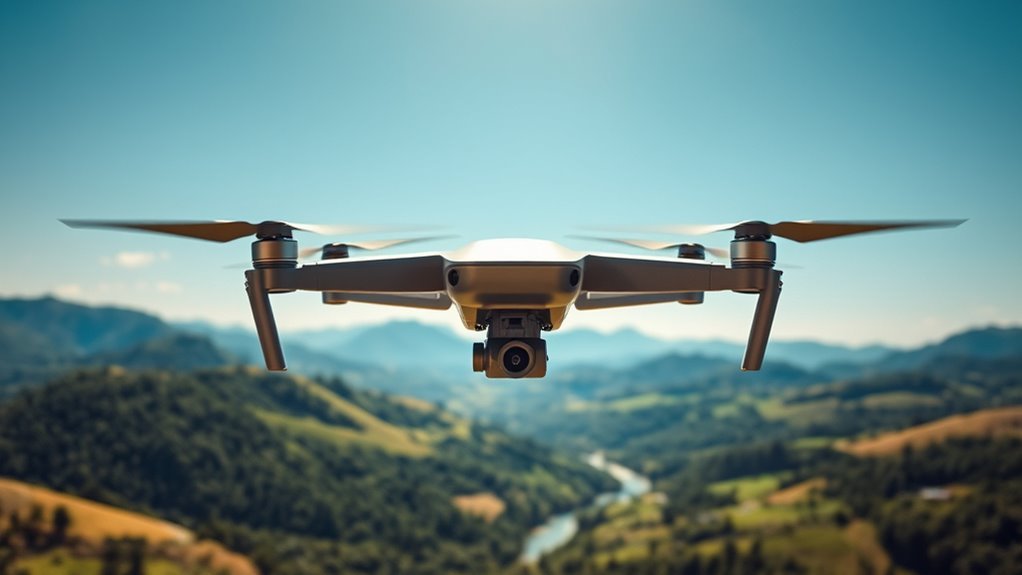Several factors will determine how far your drone can fly. Battery life and capacity directly impact flight duration, while weight and payload greatly affect performance. Environmental conditions like wind and temperature can further influence flight range. Signal strength and interference play an essential role in maintaining communication. Finally, the drone’s design and technology, plus your experience as a pilot, all contribute to overall efficiency. Explore these elements further to optimize your drone’s flight distance.
Battery Life and Capacity

Battery life and capacity are critical factors that greatly influence a drone’s flight distance. The efficiency of your battery directly affects how long your drone can operate before needing a recharge. High battery efficiency means more power for extended flights, allowing you to explore farther. When considering charging options, quick-charge technology can considerably reduce downtime, enabling you to maximize your flying sessions. Additionally, larger capacity batteries typically offer longer flight durations, but they may also impact your drone’s overall design and handling. Balancing battery size and efficiency is essential for achieving ideal performance. By understanding these aspects, you can make informed decisions that enhance your drone’s freedom to soar without limitations, ultimately extending your aerial adventures. For instance, the DJI Mavic 3 Enterprise offers an impressive flight time of up to 45 minutes, highlighting the importance of battery technology in determining flight capabilities. Furthermore, the impact of payload weight on battery performance can significantly affect overall flight time and efficiency.
Weight and Payload

When operating a drone, you must consider its weight limitations, as exceeding them can severely impact performance. The payload you choose to carry directly affects flight range, with heavier loads demanding more energy from the battery. Understanding this relationship is essential for optimizing your drone’s operational efficiency. Additionally, payload weight significantly influences overall range and performance, as excessive loads can lead to increased power consumption and reduced battery efficiency. A well-balanced weight distribution can help maximize efficiency and extend flight distances.
Drone Weight Limitations
Although many factors influence a drone’s flight distance, weight limitations—including both the drone’s own weight and the payload it carries—are crucial. The materials used in drone construction considerably affect its overall weight. Lightweight materials like carbon fiber can enhance performance, allowing for greater flight distances. Additionally, how you distribute weight plays an essential role in stability and efficiency. Proper weight distribution can minimize drag and optimize lift, ultimately affecting battery consumption and flight duration. If a drone exceeds its weight limitations, it may struggle to gain altitude or maintain control, leading to shorter flight distances. Understanding these weight limitations empowers you to make informed decisions about your drone’s capabilities and potential applications.
Payload Impact on Range
Payload plays a pivotal role in determining a drone’s flight range. When you increase your drone’s payload, its overall weight rises, which directly affects its battery life and flight performance. Proper payload distribution is essential; uneven weight can lead to decreased aerodynamic efficiency, causing your drone to consume more energy for stabilization and lift. This inefficiency can considerably shorten your flight distance. Additionally, consider the type of payload; heavier, bulkier items require more power to transport, further impacting range. To maximize your drone’s capabilities, aim for a best balance between payload weight and distribution, enhancing both stability and energy management. Ultimately, understanding how payload affects range empowers you to make informed choices for your drone operations.
Weather Conditions

While you might be keen to extend your drone’s flight distance, weather conditions play an essential role in determining its capabilities. Wind speed is a critical factor; high winds can appreciably reduce your drone’s ability to maintain stability and control, leading to shorter flight times. Additionally, temperature effects impact battery performance. Cold weather often decreases battery efficiency, limiting flight duration, while excessively high temperatures can cause overheating, resulting in automatic shutdowns. Understanding these variables allows you to plan flights more effectively. To maximize distance, aim for calm, moderate weather conditions. By factoring in wind speed and temperature, you can enhance your drone’s performance and enjoy the freedom it offers without unnecessary limitations. Furthermore, understanding discharge rates and voltage stability is crucial for predicting flight time under varying weather scenarios. Additionally, environmental conditions like humidity can also affect overall flight performance and battery life.
Signal Strength and Interference
Signal strength and interference play vital roles, as they directly impact your drone’s ability to maintain a stable connection. Understanding these factors helps you optimize performance. Consider the following:
- Signal interference from obstacles like buildings or trees can disrupt communication.
- Communication protocols dictate how your drone exchanges data with the controller, affecting range. The choice of frequency bands can also influence the reliability of the connection.
- Frequency bands used by your drone can be susceptible to external noise.
- Environmental factors, such as electromagnetic interference, can degrade signal quality. Additionally, selecting less congested bands can significantly enhance your drone’s signal integrity and overall range.
Drone Design and Technology
The design and technology of a drone greatly influence its flight distance, as various engineering choices impact efficiency and performance. Key factors include drone aerodynamics and propulsion systems. A drone’s shape affects airflow, minimizing drag and maximizing lift; this guarantees ideal performance over longer distances. Lightweight materials can further enhance flight efficiency by reducing the overall weight, allowing for more extended flight times. Propulsion systems also play an essential role; high-efficiency motors paired with advanced battery technology can greatly increase range. Combining innovative designs with superior propulsion enables drones to cover vast areas, providing you with unparalleled freedom in exploration, delivery, or surveillance. Ultimately, a well-engineered drone enhances these elements to achieve impressive distances in the sky. The Yuneec Typhoon H exemplifies how a hexacopter design can improve stability and control, contributing to overall flight performance. Additionally, modular construction in drones like the DJI Matrice allows for customization of components, which can also influence flight capabilities.
Pilot Experience and Regulations
Although many factors influence a drone’s flight distance, pilot experience and adherence to regulations play essential roles in operational success. A well-trained pilot understands both the technical and regulatory landscapes, guaranteeing greater flight efficiency and safety. Key aspects include:
- Pilot Training: Thorough education enhances decision-making in various scenarios. Knowledge of local drone laws is crucial to ensure compliance during operations.
- Regulatory Compliance: Following local laws guarantees you’re not grounded by legal issues.
- Experience Level: Seasoned pilots can manage unexpected situations, optimizing flight paths.
- Pre-flight Planning: Evaluating weather and airspace restrictions maximizes your drone’s potential. Additionally, understanding no-fly zone regulations ensures compliance and prevents unintentional violations during flight.
Frequently Asked Questions
How Does Drone Maintenance Affect Flight Distance?
Drone maintenance greatly impacts flight distance. If you neglect regular upkeep and maintenance frequency, performance can decline, leading to reduced battery efficiency and overall range. Prioritizing maintenance guarantees ideal operation and maximizes your drone’s flight capabilities.
Can Battery Type Influence Flight Range?
Yes, battery type can greatly influence flight range. Higher battery efficiency allows longer flights, while ideal weight distribution guarantees better performance. Choosing the right battery balances these factors, enhancing your drone’s operational freedom and capabilities.
What Role Does Altitude Play in Drone Range?
Altitude’s effects can feel like a superhero’s cape, dramatically altering drone range. As you ascend, air density decreases, reducing lift and battery efficiency. Consequently, understanding altitude’s role is essential for maximizing your drone’s flight capabilities.
How Do Different Drone Models Compare in Range?
When comparing different drone models, you’ll notice that specifications like battery capacity and motor efficiency greatly impact range testing. Higher-end models typically offer extended flight distances, providing you with greater freedom in your aerial endeavors.
Are There Legal Restrictions Affecting Drone Flight Distance?
You’re not just flying a drone; you’re steering through a labyrinth of drone regulations and airspace restrictions! These laws can drastically limit your drone’s potential distance, so knowing them is essential for your aerial ambitions.

